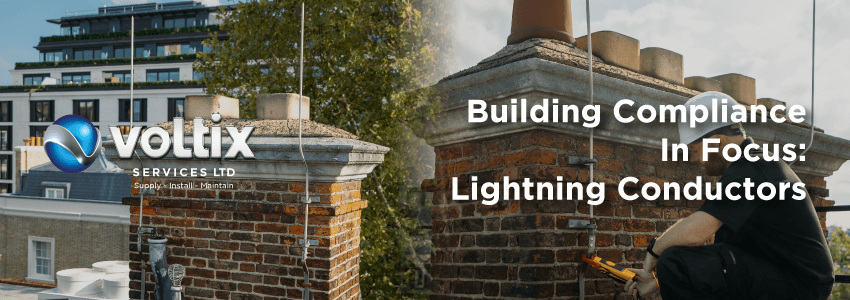Using Facilities Maintenance for Lightning Conductor Compliance
Lightning protection compliance is primarily important for the ensured safety of your buildings and their occupants. However, working with compliance professionals has some additional benefits, it also has the potential to affect your insurance premiums. Working with the right installer also means you can explore all the options that are the best aesthetic fit for your specific buildings.
As with all elements of your business’s compliance, picking the right facilities maintenance partner affects your bottom line; the complexity, time spent, and resources required to meet compliance requirements.
At Voltix Services, we provide comprehensive compliance services to businesses of all sizes. When it comes to lightning protection, our highly experienced installers are here to guide on first-time installations and ongoing maintenance for assured effectiveness for lightning protection. We also do this with comprehensive fire safety considerations and compliance requirements in mind.
Are lightning conductors a legal requirement?
It is not a legal requirement to have a lightning conductor in the United Kingdom. However, there are certain compliance requirements around this you need to adhere to. For example, electrical regulations for commercial buildings could support the need for a lightning protection system to be installed.
When is lightning protection required in the UK? Firstly, the Regulatory Reform (Fire Safety) Order 2005 mandates regular fire risk assessments. If a fire risk assessment flags a building for being vulnerable to lightning strikes, a lightning protection system could be required to meet these statutory requirements.
Various factors affect whether lightning protection systems must be installed – and the level of protection such a system must provide. Examples of factors include the size and height of the building, the nature of the business conducted within it, as well as recorded lightning strikes in the vicinity.
Section 32 of BS6651, “Protection of Structures Against Lightning”, looks at such factors in determining risk here too. The standard underscores the importance of selecting the correct materials to avoid corrosion for initial installations.
The standard also speaks to the maintenance and testing of existing systems, as well as the record-keeping and reporting that needs to take place to demonstrate compliance.
How often should lightning protection be tested in the UK?
Where lightning protection systems are installed, these should be inspected every 12 months by lightning compliance companies that are competent to do so. Lightning conductors must be checked for damage and deterioration. These inspections allow for corrosion, missing components, or issues to be addressed and corrected.
If building expansion or construction is set to take place, this may also impact your risk assessment. These lightning protection assessments are important in highlighting any issues with capability that should arise from building amendments.
Safety and compliance – simplified
Lightning protection raises important considerations around the safety of building occupants and the integrity of buildings in the event of a lightning strike. Should this occur, this raises additional concerns including the impact on business reputation, operational continuity, costs, and injury.
Voltix, the problem solvers, is here to help. We simplify compliance so you can focus on your core operations with peace of mind that your safety and compliance are covered by the best. Contact us today to find out more about our compliance solutions.

